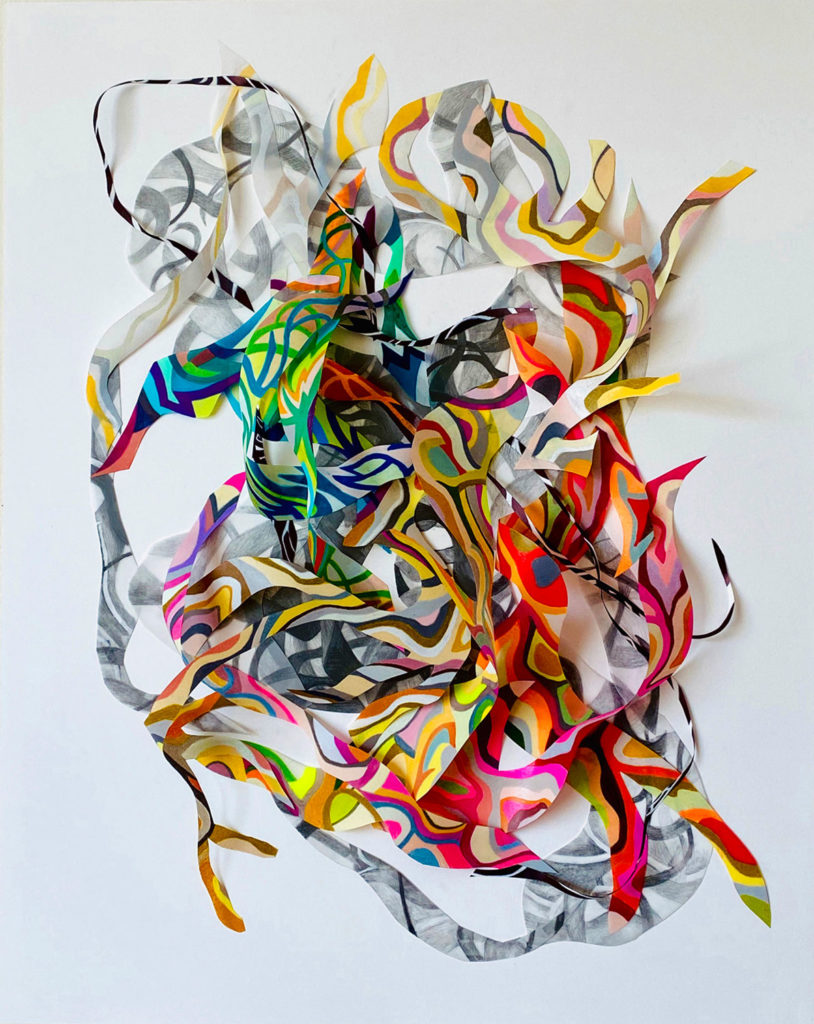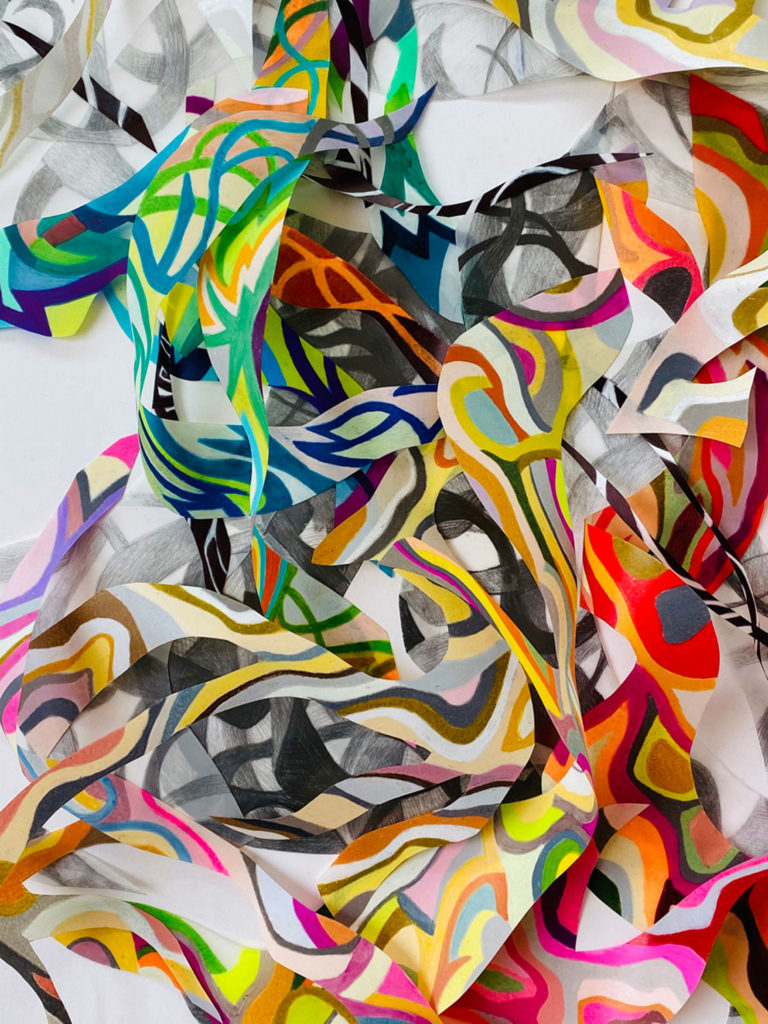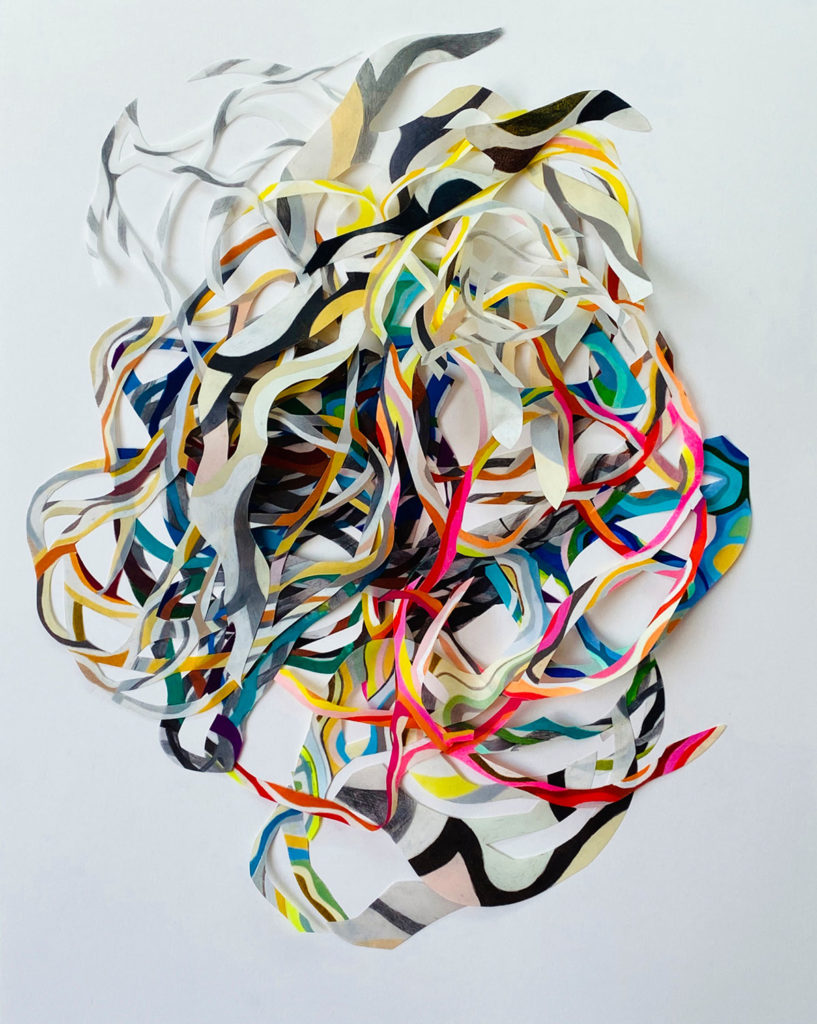TWS –Hi Holly, please tell us something you’d like people to know about yourself.
HW –I live and work in San Francisco, California and earned my MFA in New Genres at the San Francisco Art Institute. I think you could best describe my educational background as multidisciplinary because at the time, I was combining painting, performance, installation and fiber arts and trying to develop my own pathway of expression from all of this. Now in my late forties, I have come to a good place in my life where I finally am seeing who I am in my work. I think some artists find this place earlier and some find it later in their lives and I have (mostly) stopped trying to place value judgements on my process and timeline. We are where we are as a combination of our experiences and challenges and I feel like I am where I need to be right now. It is a good feeling.
TWS –You started producing figurative drawings and paintings. What led you to shift and use fragmentation as one of the key elements to create your own visual and conceptual language?
HW –As a result of a trauma response to events earlier in my life, I made fairly didactic figurative drawings and paintings that explored topics such as how rape is used as a tool of war and genocide as well as how women in general and people of color in particular are subjugated and oppressed by white, capitalistic power structures. There are also themes of labor and trade unionism in my early work as well as a great deal about the female body and my sense of discomfort with myself as so many women experience. In making this work, it was a clear re-processing of the original trauma for me but at the same time, if you go too deeply, you do not always come out on the other side. I experienced a life changing event in the form of an anorexia diagnosis in my early forties. Anorexia is a mental illness that often forces the choice of either affirming life or denying it; having this disorder was a completely clarifying experience for me. Fortunately, I had excellent care and fully recovered. But in passionately choosing and affirming life, my artwork completely changed. I started to put all the pieces of myself together which meant that I started from a place of fragmentation in the visual language that I used. It also meant that fiber arts and collage approaches started to take precedence in my practice.

19”W x 24”H, 2020

19”W x 24”H, 2020
TWS –Paper, textile, polyester, cellophane, plastic, wire and the list goes on… Which is the role of the materials you use in your artworks?
HW –The materials I use are a proxy for my body. About four years ago, I started to make installations out of string, gauze, and wire because at the time, I was recovering from the anorexia and visually, I was using materials to explore my obsession with thinness and disappearance. The power of artmaking at least in my experience is that it will not let you disappear. You only become fuller and more whole as a result of your commitment to your practice and your commitment to becoming your truest self. It literally willed me back to a love of life by teaching me about color, light and pattern. And so, the light reflective cellophane, the translucent drafting film and the origami paper started to appear in my work.
TWS –Is using found materials a political statement?
HW –I would agree that it is. I believe that artists make work in the context of the environment and the resources that they have available. The act of using found materials (vs. purchasing) also breaks away from the notion that only purchased art materials are legitimate. Reusing and recycling are fundamentally political acts in a use and throwaway society even if as artists, we are not conscious of that. While I certainly do purchase some materials for my practice such as the drafting film and the colored pencils, my studio is also filled with things I have been saving (hoarding) for years and cannot part with because they are waiting for the next moment to appear in an artwork.
TWS – In your artist statement you mention that your work celebrates female energy. Can you tell us something about this?
HW –This is something I have only become fully conscious of in recent months. As the intensive patterning and fragmentation started to appear in my work, I began to think deeply about why this was occurring. I started to read Drawing Down the Moon by Margot Adler and Spiral Dance; the Rebirth of the Ancient Religion of the Goddess by Starhawk. Both are classic feminist texts about neopaganism and the ways in which both women and men have reclaimed spirituality in a life affirming way that emphasizes joy, pleasure and personal transformation. Deep within myself, I heard a voice say, “Art is my form of magical practice which reveals the sacred in myself.” At that point, I realized that the patterning, the light and the transparency in my work was about making physical the healing energy flow of the Goddess. So, my artwork is basically energy work that seeks to materialize the force that heals and replenishes.

19”W x 24”H, 2020.

19”W x 24”H, 2020.
TWS –Can you walk us through the process of creation? How does it changes when working with installations and works on paper?
HW –In the case of my installations, I often start with what I would refer to as “energy” sketches where I draw very loosely how I want the work to flow. More how I want it to feel; not necessary even how it will look yet. I then start to intuitively cut the drafting film into a variety of shapes and draw the patterning with colored pencil, coming from a very unconscious state. In these moments in the studio, I often listen to jazz because it is an artform so rich with improvisation, texture and complexity. The jazz feeds into the energy and spontaneity of the work and encourages me to trust in the process. I think for many artists, self-doubt is the biggest killer of creativity, so I try to shut that out and literally “believe” the work into existence. The installations are very much a responsive process. I make. I look. I respond. I change. The work speaks back to me. I begin again. Because my roots are in painting and drawing, the process of making installations is not that different for me. In addition, because my mother was an excellent seamstress, the love of fabric permeates my visual approach. I “draw” the fabric in my mind. The works on paper are a more intimate experience and I will do assemblages of the drafting film as smaller scale experiments of what I want to try on a larger scale. The gouache and candle smoke paintings and the collage work I do are explorations of materials, textures, and dream states. Working small allows you to quickly explore ideas and try things that working on a larger scale does not offer. Working large and working small are both great experiences but they offer different gifts.
TWS –Is there space for improvisation in your highly complex creations?
HW –I would say that there is only space for improvisation. I don’t really have a plan or guide. I only have my instincts and my following of the energy flow in the work. If something is not flowing in the direction I need it to, I try hard not to be precious about it. In giving up the ego around it, I can make changes, kind of like pruning an overgrown garden. My work can get very layered and I am guilty of over working. So much of my process is to lay it on “thick” as it were and then take the personal freedom to edit and to reveal what is important in the work. But I have to let go of right/wrong and good/bad dualities in order to do that.

Photo credit: Al Wong, 2020.
TWS –Which is the place of change in your work? Do you plan / design the possible modifications that the artworks might suffer after being installed? Is this something that you’re looking for or you try to avoid?
HW –I think this is an excellent question. People often look at my work and ask me how on earth I am going to get that out of my studio and install it since the materials are often fragile and changeable. When I design installations, I am often doing this in response to a specific space or venue and so I am looking carefully at the floor plan, the architecture, the lighting, the movement of the people in the space, how the space is used, as well as any history of the space. I do try to anticipate any logistical issues in terms of scale, wall surfaces, etc. by asking lots of questions and not making assumptions. When the work is shipped to the space, I am fully embracing the fact that the work will be different when it is installed at the venue. I have often changed the work or expanded it to fit the environment because when you are there, you must respond to where you are as a new and original experience. Before I install work in venues, I often walk around the empty space, moving in concentric circles drawing energy from the room towards me. I pull in the energy so that I can then release out the work in a way that relates to the environment. I try to be in communion with where I am. To listen and then to respond. I cannot avoid the work changing nor can I impose my will because my work is all about the natural flow of energy and sickness develops when energy is trapped by my own willfulness.
TWS –Which is the role of the artist in the present political situation?
HW –I think the role of the artist in the present situation is driven personally by everyone’s experience. I am married to a Chinese American thus my last name; I myself am white and as an artist, I recognize that amplifying the voices of artists of color is critical. Examining my own privilege as a white woman and being willing to listen and be vulnerable around this is critical. Supporting antiracism efforts directly and advocating for reallocation of resources from militaristic policing tactics to community mental health and substance use treatment and de-escalation is another form of direct action. There are a number of artists doing extraordinary work in the genre of Social Practice art and I think these projects are transformational. There are also artists whose work is not directly political, yet these individuals contribute to the movement for justice in other ways such as contributing financially and supporting organizations that are doing the front-line work. I think all these approaches are valid; what is clear to me though is that none of us can afford to stand on the sidelines.

3.5’W x 3.5’H, 2020.

3.5’W x 3.5’H, 2020.
TWS –Which is your definition of collage?
HW – I think one of the reasons I love collage art so much is because it is literally a mapping of what the artist touches and is influenced by in their environment. A cultural fingerprint of sorts. Collage can literally be the layering of cut paper elements on a rigid surface, but it can be more broadly thought of as a way of thinking. Collage artists are profoundly resourceful, inventive and boundary spanning and so this can include how one might approach installation or other three-dimensional works. I love the “all in” nature of collage thinking. Nothing is precious and everything is precious at the same time. It is all integrated and its very fragmentation leads to wholeness.
More Holly Wong at her site or Instagram

3’W x 3.5’H, 2020.

3’W x 3.5’H, 2020.


Photo credit: Al Wong, 2020.

14’W x 8’H x 6’D, 2020.


